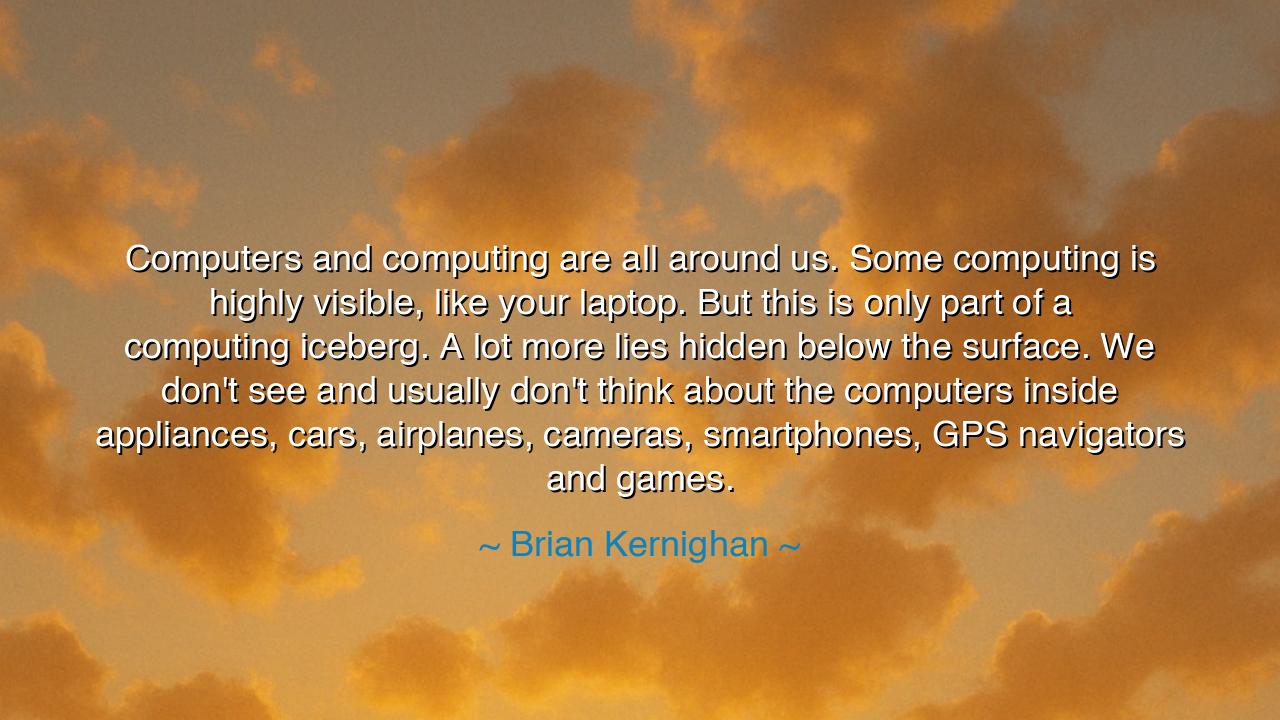
Computers and computing are all around us. Some computing is
Computers and computing are all around us. Some computing is highly visible, like your laptop. But this is only part of a computing iceberg. A lot more lies hidden below the surface. We don't see and usually don't think about the computers inside appliances, cars, airplanes, cameras, smartphones, GPS navigators and games.






In the wise and reflective words of Brian Kernighan, one of the great sages of the digital age, we find a truth that reveals both the wonder and the hidden power of our modern world: “Computers and computing are all around us. Some computing is highly visible, like your laptop. But this is only part of a computing iceberg. A lot more lies hidden below the surface. We don't see and usually don't think about the computers inside appliances, cars, airplanes, cameras, smartphones, GPS navigators and games.” Though he speaks of machines, his words carry the tone of a philosopher warning the people of an unseen force — one that both serves and shapes them. For in every age, the greatest power is not the one that shouts, but the one that works silently beneath the surface.
In this image of the “computing iceberg”, Kernighan invites us to see our world not as it appears, but as it truly is. The visible part — our laptops, our phones, the glowing screens that captivate our eyes — is but a small fragment of the vast digital ocean that surrounds us. Beneath that shimmering surface lies the invisible machinery of modern life: the embedded systems that govern engines, regulate flights, control power grids, monitor hospitals, and guide satellites through the heavens. These hidden computers do not call attention to themselves, yet they uphold the entire architecture of civilization. Like the unseen roots of a great tree, they sustain life quietly, and only when they fail do we realize their importance.
The origin of this insight comes from Kernighan’s long journey as a pioneer of computer science. As one of the creators of the C programming language and a collaborator in the birth of UNIX, he helped lay the foundations of the very systems that now dwell invisibly within the fabric of modern existence. But having seen both the creation and evolution of computing, he speaks not only as a builder but as a seer. His words remind us that in our daily lives, we are surrounded by intelligence — not of the human kind, but of code and circuitry — performing billions of operations beyond our awareness. In his teaching, there is both awe and caution: awe for the marvel of human invention, and caution for the blindness that comes when we forget what we depend upon.
Consider the fate of the Mars Climate Orbiter, a spacecraft launched with hope and precision in 1998. It was lost not because of a failure of courage or engineering brilliance, but because of a hidden error deep within its computational systems — a mismatch between metric and imperial units. One unseen flaw in code led to the destruction of an entire mission, costing millions and silencing a dream. This story, like Kernighan’s iceberg, reveals how the unseen in computing wields tremendous power. What we do not see — what lies below the surface — can define success or catastrophe. The ancients might have called this fate; today, we know it as the silent consequence of neglecting what we do not understand.
Kernighan’s words also speak to a larger philosophical truth: that the world we inhabit is layered, and wisdom lies in perceiving what is hidden. In every era, mankind has been seduced by appearances — by the visible flame, forgetting the fuel; by the city, forgetting the foundations. In our time, it is technology that dazzles the eye, while its inner workings remain a mystery to most. To live wisely in this age, we must look beneath the surface, to understand not only how to use our tools, but how they shape our lives. For every appliance, every vehicle, every network, carries within it a silent will — the code written by unseen hands, the logic that directs motion, communication, and even thought. To ignore these hidden systems is to live like one walking over ice, unaware of the deep and shifting waters below.
Yet Kernighan’s message is not one of fear, but of awareness. He calls us not to distrust technology, but to understand it, to see through its veil and reclaim mastery over the tools we have built. The ancients studied the stars to guide their journeys; we must now study the algorithms that guide our lives. The wise user, like the wise sailor, learns not only to steer but to read the currents beneath the waves. In this understanding lies both safety and empowerment — the ability to navigate a world woven with invisible code, to remain master of one’s destiny even in the digital storm.
Let this then be the lesson for our time: do not live only upon the surface. Be curious about the systems that sustain you. Learn how your world functions — the networks, the programs, the machines that hum quietly in your home and in your city. For every light that shines depends on what lies in shadow, and wisdom begins when we pierce that darkness with knowledge. As Brian Kernighan teaches, the visible world of technology is but a fragment; true understanding lies in what is hidden below.
And so, O listener, take heed: the age of invisible computing is the age of unseen power. Seek not only to use, but to know. For the world of machines grows vast and silent, and those who do not understand its depths may one day find themselves adrift upon it. But those who, with humility and courage, look beneath the surface — they shall command the current, not be swept away by it.






AAdministratorAdministrator
Welcome, honored guests. Please leave a comment, we will respond soon